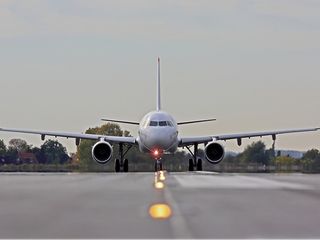Nordic-based carriers will introduce the Braking Action Computation Function (BACF) on A320 Family aircraft
A new functionality for Airbus jetliners literally turns an aircraft into a moving sensor during landing – providing real-time data on potentially challenging or dangerous runway conditions created by rain, snow or freezing water.
Developed through a project of Airbus and its NAVBLUE subsidiary for airline operations software, this technology enables pilots to more accurately evaluate the braking action the aircraft experienced during landing.
Called the Braking Action Computation Function (BACF), it highlights Airbus and NAVBLUE’s commitment to safety and accident prevention. This technology helps address the biggest category of accidents, which are so-called “runway excursions,” when an aircraft departs the runway. Runway excursions often occur when the runway is contaminated, particularly with standing water, snow and/or ice – which is where BACF is expected to help.
First BACF adopters: Finnair, SAS and Novair
In time to meet cold winter conditions, a trio of Nordic airlines – Finnair, Scandinavian Airlines System (SAS) and Novair – are the first to sign up for the full BACF solution. This facilitates a controlled entry-into-service on their Airbus single-aisle A320 Family jetliners, enabling the build-up of experience before the system’s wider roll-out in 2019.
“It’s great that our first customers are those with some of the most challenging winter conditions,” said Eric Le Roux, the BACF Project Leader at Airbus. “It’s going to be very exciting to work with Finnair, SAS, Novair and their airports to see how they adapt their operations using this technology.”
The BACF functionality uses data from an aircraft’s deceleration during landing, comparing this information against different reference runway conditions. Additionally, using GPS information from the aircraft navigation systems, it is possible to identify which section of the runway the aircraft is on when a runway state is identified.
More users = better data on runway conditions
This information is displayed on the cockpit’s Multifunction Control & Display Unit (MCDU), enabling pilots to radio their inputs to air traffic controllers, to be shared with the crew of incoming planes landing at the airport. The calculated BACF data also is sent automatically by digital link to NAVBLUE, which collects and displays the results on its RunwaySense web application. The RunwaySense technological approach is similar to mobile apps that allow drivers to see and avoid traffic jams.
Users of RunwaySense are expected to include airports, airlines’ operational centres, and air traffic controllers, enabling them to view runway condition information across an entire airport or on individual runways. By sharing reports in real-time, the applications’ users will better understand how runway conditions are trending, and airports can anticipate and mitigate slippery conditions. As additional aircraft participate in data sharing, the better the real-time mapping of conditions becomes.
As Logan Jones, NAVBLUE’s runway safety specialist, explained: “With BACF, each aircraft is supplying a piece of the puzzle, and the RunwaySense platform we’ve built allows airports to see the picture come together. The more aircraft that send reports, the better the map of conditions becomes, and the easier it is for airports to know when to take action to mitigate slippery conditions.”
Access to BACF for airlines, airport and air traffic controllers
Airlines that contribute to BACF will have basic access to the RunwaySense web platform to visualise and track all the reports sent by their aircraft; they also can choose to receive additional information about flight conditions at key airports across their route network. For airport and ATC users, access to RunwaySense will be possible through a paid subscription.
RunwaySense continues Airbus and NAVBLUE’s ongoing commitment to improving safety by exploiting the capabilities of the latest technologies, including its recent development of the Runway Overrun Prevention System (ROPS) which alerts pilots when the runway length could be exceeded while landing.
- More information on BACF and RunwaySense is available on Airbus’ “Safety First” website.
- Review Airbus’ statistical analysis of commercial aviation accidents.

